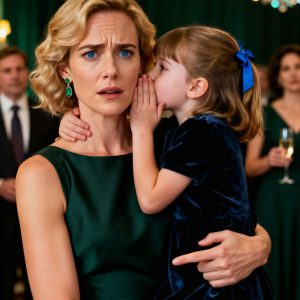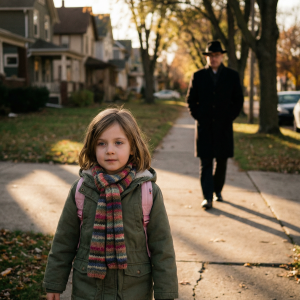Carrying the Unbearable
I’m Marcus, and this is how an unexpected meeting in a graveyard taught me the profound difference between cherishing memories and becoming their prisoner.
When Everything Changed
Three years had elapsed since that devastating call, yet it remained crystal clear in my memory. I was buried in financial reports at my office when the hospital’s urgent voice shattered my ordinary Tuesday afternoon.
“Mr. Henderson, your wife has been in a serious accident. Please come right away.”
Catherine was heading to her weekly sister lunch when an intoxicated driver ignored a traffic signal. The collision was fatal, the medical team explained, assuring me her suffering was brief. Cold comfort when the person who shared morning coffee with me for eight years vanished in an instant.
The memorial service became a haze of floral arrangements, sympathetic words, and relatives promising that healing would eventually come. Yet I learned that time doesn’t mend wounds—it simply changes how we bear the weight.
Months following Catherine’s passing, I functioned like a performer who’d lost his script. Work continued, bills got paid, life’s mechanics persisted, yet everything felt empty and artificial. Our shared home transformed into a shrine where every item held emotional significance.
Her ceramic mug stayed exactly where she’d placed it that last morning in the dishwasher. Books remained open to pages she’d never complete, bookmarks holding their eternal vigil. Changing anything felt like erasing her existence from the world.
Well-meaning loved ones suggested counseling, encouraged new relationships, pushed me to “rebuild my future.” Yet that concept felt like betrayal. How could rebuilding mean abandoning Catherine’s place in my heart?
Unexpected Warmth
Two years later, at an urban development conference where we both presented research, I encountered Rachel. She possessed intelligence, empathy, and that rare quiet confidence that earns respect without demanding it.
Our connection developed gradually through work discussions that slowly expanded into personal stories, mutual interests, and cautious conversations about tomorrow. Rachel understood Catherine’s significance from our first meeting—I’d discovered that transparency about loss was crucial for authentic relationships.
Rachel’s patience with my emotional barriers impressed me most. She never insisted I stop mentioning Catherine or demanded photo removal from my space. She grasped that grief wasn’t a puzzle requiring solutions but a permanent shift in my heart’s landscape.
“Love isn’t rationed,” she observed during an evening walk through the park where Catherine and I used to exercise. “Loving her doesn’t prevent loving again. It proves your heart holds space for both.”
Her insight resonated intellectually, though emotionally I remained resistant to happiness without Catherine.
The Question and the Fear
Following eighteen months together, I proposed to Rachel one peaceful Sunday while she prepared breakfast and hummed unfamiliar melodies. The moment felt simultaneously natural and terrifying—natural because Rachel had become integral to my contentment, terrifying because it acknowledged Catherine’s permanent absence.
Rachel accepted through tears and immediately began wedding planning that would honor our future while respecting the past that shaped us. She insisted on visiting Catherine’s resting place before choosing our date, wanting to “meet” the woman whose loss had influenced our entire courtship.
“I’m not her replacement,” Rachel declared as we stood before Catherine’s granite marker. “I just want her to know you’ll be cherished.”
This gesture touched me deeply while crystallizing a nagging worry: perhaps my feelings for Rachel stemmed from gratitude for accepting my brokenness rather than genuine romantic love.
As our ceremony approached, doubt consumed me. Did I love Rachel for herself, or for who she wasn’t? Was marriage about building something together, or avoiding solitude with my sorrow?
The Final Visit
Our wedding eve found me at Riverside Cemetery carrying white roses and overwhelming uncertainty. I needed one last conversation with Catherine before promising myself to another, though my purpose remained unclear.
Only wind through oak trees disturbed the cemetery’s peace. Monthly visits for three years had become routine, but tonight carried finality—tomorrow would make these solitary discussions feel like betrayal of my new marriage.
I arranged flowers on her grave and began the rehearsed conversation.
“Rachel and I marry tomorrow,” I addressed the engraved stone bearing Catherine’s details. “You’d appreciate her. She’s gentle, patient, and doesn’t ask me to forget you.”
Words felt insufficient for my emotional complexity. Love, guilt, hope, and terror battled within me as I struggled to articulate this transition’s meaning.
“I’m uncertain whether my feelings for her represent genuine love or terror of eternal loneliness,” I confessed. “I don’t know if loving someone new while still loving you is even possible.”
Footsteps on gravel interrupted my thoughts. A woman in her thirties approached with her own flowers, hesitating upon seeing me in this private moment.
“Sorry,” she said quietly. “I didn’t expect anyone here. I’ll return later.”
“Stay,” I replied, wiping unexpected tears. “We’re all mourning someone.”
An Unexpected Connection
The woman, Sofia Martinez, was visiting her brother Miguel, killed in a motorcycle crash two years prior. Our conversation revealed Miguel was twenty-six, an engineering student planning to propose to his girlfriend the week following his death.
“He was so excited about the engagement ring,” Sofia shared while arranging carnations on his grave. “He insisted I help him choose because he wanted feminine perspective. He was terrified she wouldn’t like it.”
The parallel to my own proposal anxiety with Catherine eight years earlier struck us both.
“How do you continue after something like that?” I asked, uncertain whether I meant Miguel’s death or Catherine’s.
“Some days I don’t,” Sofia admitted. “Some days I call his phone for his voicemail. Some days I cook his favorites then remember he won’t come home.”
We talked for hours, exchanging stories about our lost loved ones and grief’s transformative power. Sofia worked in pediatrics at the same hospital where Catherine died—too meaningful for coincidence.
“Do you think they’re aware we’re here?” she wondered as we prepared to leave.
“I think they want our happiness,” I answered, hoping I believed it.
“Even if happiness means release?”
That question haunted my drive home to final wedding preparations.
The Ceremony
Rachel was luminous walking down our small chapel’s aisle, chosen for its intimate atmosphere and stunning stained glass. Her dress was elegant simplicity, her smile genuine and hopeful for our shared future.
Standing at the altar watching her approach, I experienced tangled emotions I couldn’t separate. Love for Rachel certainly, but also persistent ache for Catherine’s absence from this purely joyful moment.
The ceremony flowed smoothly until traditional vows about forsaking all others. The phrase froze me as I realized “all others” included not just future temptations, but the past love I’d clutched like a lifeline.
Rachel sensed my hesitation and squeezed my hand reassuringly, her eyes showing understanding rather than worry. In that instant, I understood she’d always known this day would challenge me, and her love was strong enough to accommodate my struggle.
We exchanged rings and kissed as spouses while families applauded, yet part of me remained in that cemetery, discussing the impossibility of loving across death’s divide.
Honeymoon Struggles
Our Vermont bed-and-breakfast honeymoon surrounded us with mountains and early autumn maples. It should have been perfect newlywed bliss, but I remained distracted and emotionally absent.
On day three, Rachel addressed my state directly.
“You’re not present with me,” she observed over sunrise coffee on the porch. “Your body’s here, but your heart isn’t.”
Her accuracy stung. Despite good intentions, I’d been comparing every honeymoon moment to Catherine trips, finding our new experiences lacking against idealized memories.
“I’m trying,” I offered weakly.
“I know. But Marcus, I need to understand—did you marry me from love, or fear of being alone?”
Her directness forced confrontation with doubts I’d been avoiding since our engagement. Did I love Rachel for herself, or was she simply the best alternative to solitude?
“I don’t know,” I admitted. “I thought I did, but now nothing feels certain.”
Rachel contemplated silently, watching mountains emerge from morning mist. When she spoke, her voice carried calm sadness.
“We should see a counselor when we return,” she decided. “Both of us. I deserve more than being someone’s consolation prize, and you deserve marriage built on love instead of fear.”
Professional Guidance
Dr. Patricia Weiss specialized in grief counseling and had helped many people navigate new relationships after spousal death. Her office radiated warmth and comfort, designed to encourage honest conversation.
“Grief isn’t a solvable problem,” she explained during our first joint session. “It permanently changes how you experience life. The goal isn’t ‘getting over’ Catherine’s death—it’s learning to carry that love forward without preventing new intimacy.”
She helped me understand my attachment to Catherine had become unhealthy, not because I still loved her, but because I was using that love as protection against vulnerability required for genuine intimacy with Rachel.
“You fear that loving Rachel completely would somehow diminish your love for Catherine,” Dr. Weiss observed. “But love isn’t zero-sum. Less grief doesn’t mean less love.”
Through months of individual and couples therapy, I began distinguishing between honoring Catherine’s memory and being imprisoned by it. Rachel participated willingly in sessions that must have pained her, demonstrating strength and commitment that humbled me.
Another Encounter
Six months into marriage, I met Sofia Martinez again at a trauma-informed care conference where we both presented research. Seeing her outside the cemetery felt surreal, like encountering a dream character in reality.
Over post-presentation coffee, we discussed how our lives had evolved since that cemetery night. She’d started dating—a fellow nurse who understood her need to maintain connections to Miguel’s memory while building new relationships.
“I realized Miguel wouldn’t want me to stop living because he couldn’t,” she told me. “He always encouraged my happiness while alive. Death didn’t change that.”
Her perspective clarified my situation. Catherine had never been possessive or jealous during our marriage; she’d always encouraged my pursuit of happiness and fulfillment. Why would death have altered those fundamental aspects of who she was?
The Breakthrough
The turning point came during a therapy session where Dr. Weiss asked me to write Catherine a letter explaining my guilt about loving Rachel. The exercise forced articulation of avoided fears:
“I’m afraid that loving Rachel completely means our love wasn’t special. I’m afraid happiness without you means I didn’t love you enough. I’m afraid moving forward means abandoning you.”
Reading the letter aloud to Rachel was among the most difficult things I’d ever done, but her response surprised me.
“Those fears make sense,” she said. “But Marcus, I fell in love with a man who had loved deeply and lost deeply. That capacity for love attracted me to you. I’m not asking you to stop loving Catherine—I’m asking you to love me too.”
The distinction was subtle but profound. Rachel wasn’t competing with Catherine for my affection; she was asking inclusion in a heart that had proven capable of deep love.
Shared Sacred Space
A year after our wedding, Rachel and I visited Catherine’s grave together. It was my first time bringing anyone else to this sacred space, and I was nervous about sharing this ritual with my new wife.
Rachel brought sunflowers—Catherine’s favorites—and stood quietly during my usual conversation with the headstone. But this time, my words were different.
“Catherine, I want you to meet my wife, Rachel,” I said, feeling awkward but determined to push through discomfort. “She’s been patient with my grief, and she loves me despite my broken places.”
Rachel stepped forward and touched the gravestone.
“Thank you for teaching him how to love,” she said simply. “I promise to treasure that gift.”
Standing there together, I realized bringing Rachel to meet Catherine wasn’t betraying either woman—it was integrating different parts of my life into a coherent whole.
New Understanding
Over following months, I began understanding that my love for Catherine and Rachel weren’t competing. They were different relationships serving different purposes in my life’s narrative.
Catherine represented my youth, my first experience of deep love, and the man I’d been before grief changed me. That love would always be perfect and unchanging because death had frozen it at its peak.
Rachel represented growth, healing, and the man I was becoming through learning to live with loss. Our love was more complex because it included struggle, compromise, and the daily work of building life together.
Both loves were real, both were valuable, and both deserved honor without apology or qualification.
Professional Integration
My experience with grief and recovery began influencing my urban planning work. I started focusing on projects helping communities create meaningful memorials and healing spaces for people dealing with loss.
Rachel and I collaborated on a downtown meditation garden proposal where families could remember loved ones while remaining part of the living community. The project combined my understanding of grief with her landscape architecture expertise.
Working together professionally deepened our personal relationship unexpectedly. We discovered we made an excellent team when focused on external goals rather than constantly examining our internal dynamics.
Growing Family
Two years into marriage, Rachel became pregnant with our first child. The planned pregnancy was welcome, but it forced us to confront questions about how Catherine’s memory would fit into our growing family.
“I want our children to know about Catherine,” Rachel said during an evening walk. “She was important to you, which makes her important to our family history.”
“Are you certain?” I asked. “It might be easier to just focus on our life together.”
“Easier for whom? Our children deserve to understand all the experiences that shaped their father. Catherine’s love made you the man I fell in love with.”
Her generosity continued amazing me. Rather than seeing Catherine as a threat to our family’s cohesion, Rachel viewed her as part of the foundation that had made our love possible.
New Life
Our daughter Emma was born on a snowy February morning after twelve hours of labor that tested both our endurance and partnership. Holding her for the first time, I felt love completely different from what I’d experienced with either Catherine or Rachel—fierce, protective, and uncomplicated by past loss’s weight.
In weeks following Emma’s birth, I found myself thinking less about Catherine and more about the future we were building as a family. The shift wasn’t conscious or deliberate; it simply happened as my emotional energy focused on present rather than past.
Rachel noticed the change without direct comment. She simply smiled when she caught me staring at Emma with wonder, or when I discussed plans for family vacations and milestones we would celebrate together.
Integration
Five years after Catherine’s death and three years into my marriage with Rachel, I finally achieved something I’d never thought possible: peace with the complexity of loving multiple people across time.
I still occasionally visited Catherine’s grave, but the conversations were different. Instead of asking permission to move forward, I shared updates about the life I was building and the happiness I’d found.
“Emma said her first word yesterday,” I told the gravestone during one visit. “She’s beautiful, Catherine. I think you would have loved being an aunt.”
Catherine’s absence still pained me, but it had transformed into something more manageable—bittersweet appreciation for what we’d shared rather than desperate grief for what we’d lost.
Sharing Wisdom
Rachel and I started facilitating a support group for people navigating relationships after spousal death. Our experience, combined with professional training, helped us guide others through the specific challenges of loving again after loss.
“The goal isn’t replacing your first love,” I would tell new group members. “It’s expanding your definition of what love can be.”
We met people at every grief and recovery stage—some still raw from recent loss, others years into new relationships but still struggling with guilt and comparison. Each story reinforced our understanding that there is no single correct way to honor the past while building the future.
The Continuing Journey
Today, ten years after Catherine’s death and seven years into my marriage with Rachel, our family includes Emma and her younger brother Michael. Our house fills with children’s laughter, homework sessions, and bedtime story chaos and joy.
Catherine’s photo still sits on my nightstand, but it no longer dominates the space. It shares the surface with pictures of Rachel and the children, creating a visual timeline of love’s evolution rather than a shrine to love’s end.
The children know about Catherine through age-appropriate stories about their father’s first marriage. They understand she was important to me and her death was very sad, but they don’t see her as competition for my affection.
“Daddy loved Catherine when he was younger,” Emma explained to a friend during a playdate. “Now he loves Mommy and us. People can love lots of people.”
Her matter-of-fact acceptance of love’s complexity reminded me how much wisdom children possess about matters adults complicate through overthinking and fear.
Reflections on Love and Memory
Looking back on the journey from devastating grief to integrated healing, I understand now that the question was never whether I could love again after Catherine’s death. The question was whether I would allow myself to love differently.
Rachel never asked me to forget Catherine or pretend our marriage was my first experience with deep love. She simply asked me to make room in my heart for new experiences while honoring the old ones.
That cemetery night when I met Sofia, I was seeking Catherine’s permission to move forward with my life. But permission was never Catherine’s to give or withhold—it was mine to claim.
The love I shared with Catherine taught me I was capable of deep emotional connection. The love I share with Rachel has taught me that the heart’s capacity for connection is infinite when we stop treating love as a finite resource.
Grief, I learned, isn’t love’s opposite—it’s love with nowhere to go. The challenge isn’t stopping grief, but finding constructive places for that ongoing love to live alongside new relationships and experiences.
Daily Practice
Marriage to Rachel requires daily choices to be present and engaged rather than lost in memory or paralyzed by comparison. Some days are easier than others. When Emma laughs, she sounds exactly like Catherine did, which can bring unexpected sadness even amid joy.
But Rachel has taught me that acknowledging those moments doesn’t threaten our marriage—pretending they don’t exist does. We’ve built a relationship strong enough to accommodate human emotion’s complexity rather than demanding its simplification.
“I married all of you,” Rachel reminded me recently when I apologized for being melancholy after visiting Catherine’s grave. “The parts that loved before, the parts that grieved, and the parts that learned to love again. I don’t want an edited version of who you are.”
Her acceptance has been the foundation of our happiness together, but it took me years to understand I had to accept myself with the same generosity.
Larger Lessons
My experience has taught me several important truths about love, loss, and the human capacity for emotional growth:
First, grief is not a problem to be solved but a permanent alteration in how we experience the world. The goal isn’t to “get over” loss but to integrate it into a life that can still include joy and connection.
Second, new love after loss is not a betrayal of previous love—it’s a testament to love’s power to transform rather than simply replace what came before.
Third, the heart’s capacity for love is not diminished by loving multiple people across time. If anything, experiencing deep loss can increase our appreciation for love when we find it again.
Finally, healing requires both holding on and letting go—holding onto the gifts that previous relationships brought to our lives while letting go of the fantasy that those relationships could continue unchanged by death or separation.
The Continuing Story
Emma is now eight and Michael is five, and they have no memory of a time when their father was defined primarily by grief rather than joy. They know I was married before and that Catherine died, but those facts are simply part of their family history rather than sources of anxiety or confusion.
Rachel and I have built a marriage based on honesty about our respective pasts and shared commitment to our future together. We still attend therapy occasionally, not because our relationship is troubled but because we believe in the value of professional guidance for navigating life’s complexities.
I think Catherine would be pleased with how my life has evolved. She always wanted me to be happy, and happiness was something I thought had died with her. Learning it could be resurrected in new forms was perhaps the greatest gift of my relationship with Rachel.
The man who stood in that cemetery seeking permission to love again has been replaced by someone who understands that love doesn’t require permission—it simply requires courage. The courage to risk loss again, to be vulnerable again, and to trust that the heart can hold more than we ever thought possible.
Today, when I visit Catherine’s grave, it’s not to ask for guidance or seek absolution. It’s simply to say thank you—for the love we shared, for the lessons her death taught me, and for the capacity for happiness that her memory helped me preserve even in grief’s darkest moments.
The roses I leave there now are symbols of gratitude rather than mourning, tokens of a love that has been transformed but never diminished by time, distance, or the presence of new love in my life.





